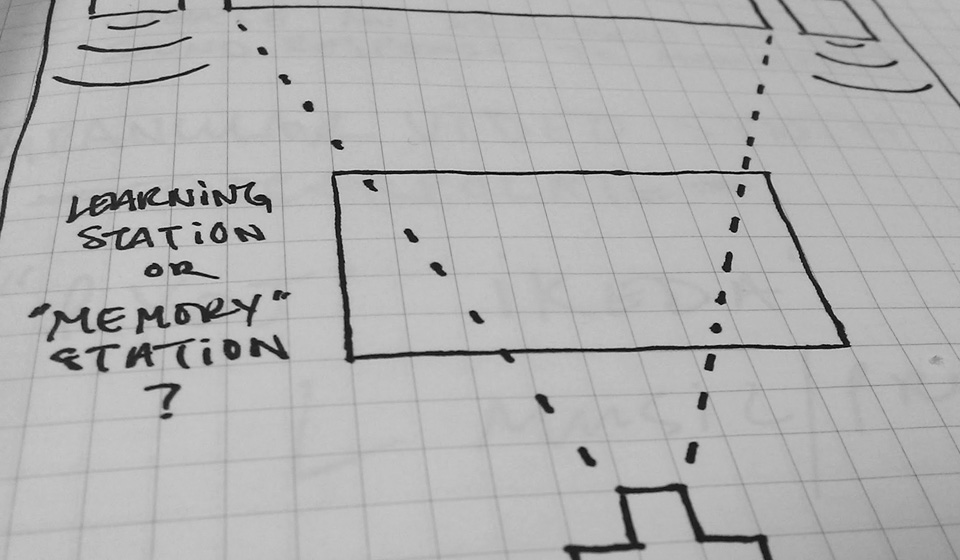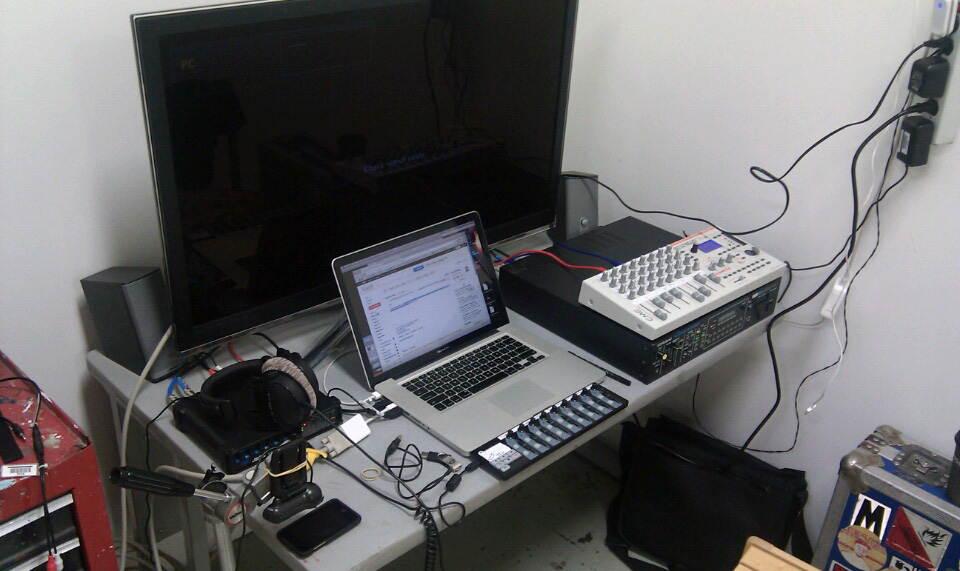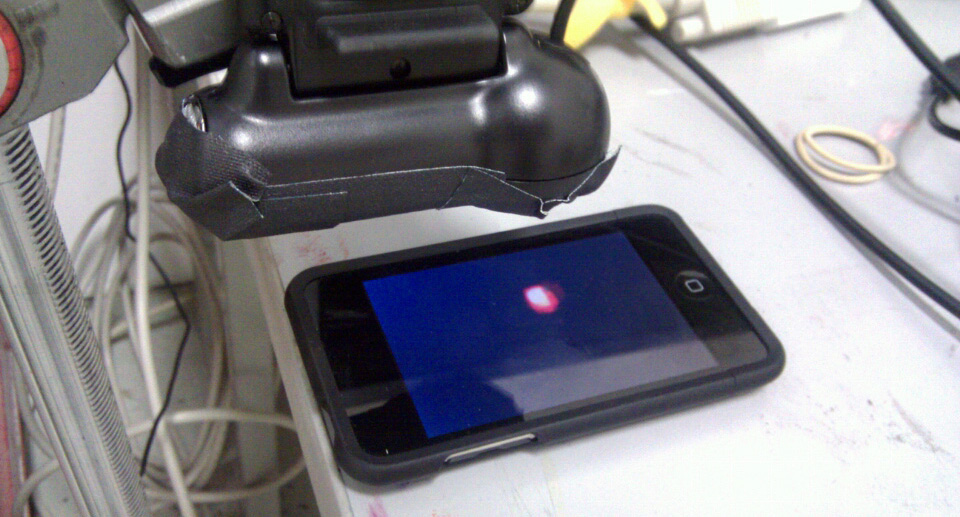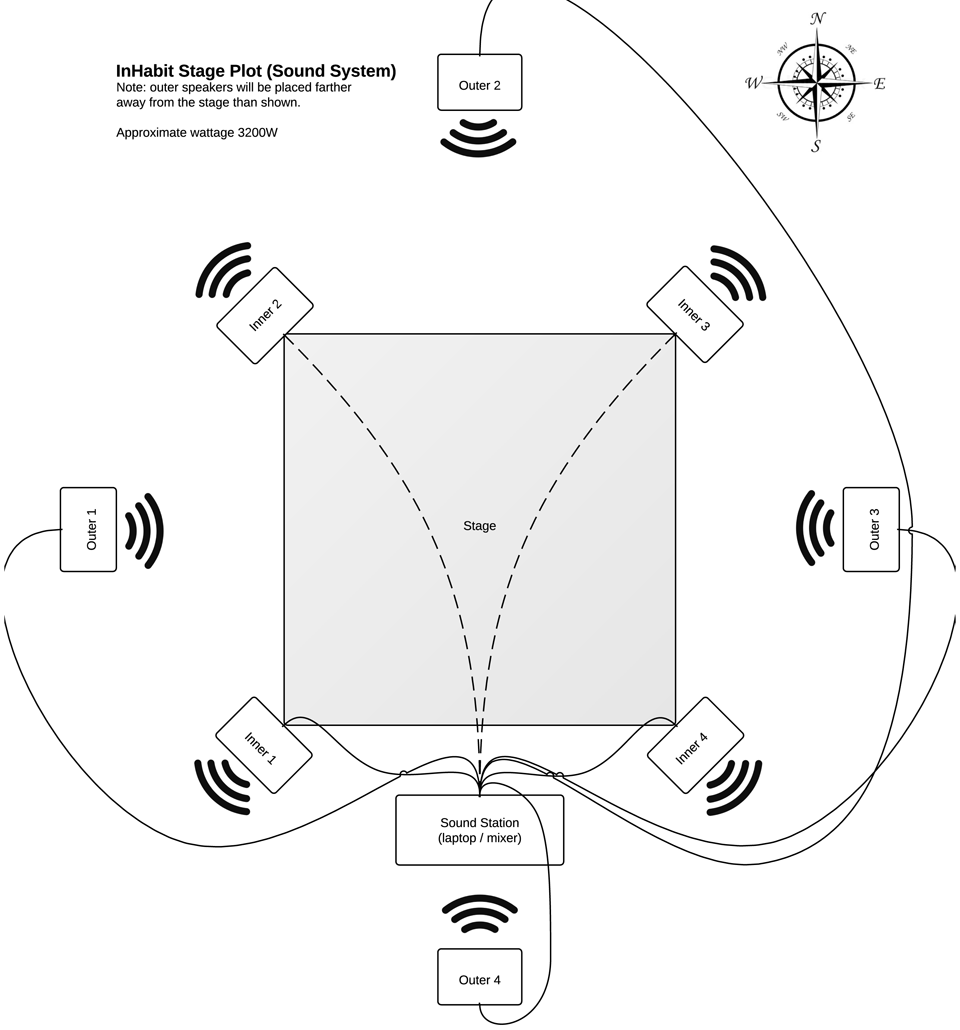John Keston
MCAD Process Book
-
Statement
 As a performing musician and composer, I am reevaluating my sentiments on music and sound within the context of art. My combined backgrounds in music technology and software development have led me to adopt music, sound, moving images, and interactivity as the primary modalities in my artistic practice. My process involves building software and hardware based instruments that respond to touch, light, or video signals. Using these tools I compose music, and produce interactive performances and installations. Through these methods I am questioning how our psyches respond to auditory signifiers as we subject ourselves to endless streams of technology driven media.
As a performing musician and composer, I am reevaluating my sentiments on music and sound within the context of art. My combined backgrounds in music technology and software development have led me to adopt music, sound, moving images, and interactivity as the primary modalities in my artistic practice. My process involves building software and hardware based instruments that respond to touch, light, or video signals. Using these tools I compose music, and produce interactive performances and installations. Through these methods I am questioning how our psyches respond to auditory signifiers as we subject ourselves to endless streams of technology driven media.
My performances and installations are collaborative, multi-sensory experiences combining the fragile gloss of digital imagery with improvised or generative passages of synthesized sound. At times, multiple layers of abstraction emphasize imperfections in the digitized media, while parameters in the software uncover an eerie familiarity in the musical forms. My approach is often experimental and mostly abandons verbal messages and symbolism in favor of ambiguous, textural, and contemplative content. In this way I attempt to redirect the observer’s consciousness inward, perhaps discovering something internal that might otherwise be obscured by the programming we continually receive via media channels.
“The dominant, continuing search for a noiseless channel has been — and will always be — no more than a regrettable, ill-fated dogma.” — Rosa Menkman
Swipe, Arrow, or Press to Advance
-
Voice Lessons (overview)
 Voice Lessons (2011—2012) is an electronic audio device that interrogates the popular myth that every musical instrument imitates the human voice. Touching the screen allows the participant to manipulate the visuals and vocalizations of the “voice teacher” as he recites vocal warm up exercises.
Voice Lessons (2011—2012) is an electronic audio device that interrogates the popular myth that every musical instrument imitates the human voice. Touching the screen allows the participant to manipulate the visuals and vocalizations of the “voice teacher” as he recites vocal warm up exercises.
The piece hovers in the space between a musical instrument and a voice lesson. Move the touch point left, right, up, and down to explore the visual and auditory possibilities. Rapid, high-pitched loops occur while touching near the top of the screen while slower, low-pitched loops are heard near the bottom. These loops expose harsh glitches and mechanical rhythms hidden inside the digital content. The actor, also named John Keston, is my father who became a voice teacher after a long career on stage in plays, operas, and musicals with the Royal Shakespeare Company in our native country, England, and abroad.
 This collaborative work between me, my father, and visitors who interact with the installation was featured on Wired.com, Wired.co.uk, and CreativeApplications.net. Voice Lessons was also selected for the exhibit Accumulation (January, 2012), juried by John Rasmussen of Midway Contemporary Art.
This collaborative work between me, my father, and visitors who interact with the installation was featured on Wired.com, Wired.co.uk, and CreativeApplications.net. Voice Lessons was also selected for the exhibit Accumulation (January, 2012), juried by John Rasmussen of Midway Contemporary Art.
-
Voice Lessons (process)
 MaxMSP was used to build the Voice Lessons project. The software runs on a computer attached to a 32” touch screen display. Users operate the software by touching the screen. Granular synthesis techniques are applied to the sound and video in parallel, based on where the user touches the display.
MaxMSP was used to build the Voice Lessons project. The software runs on a computer attached to a 32” touch screen display. Users operate the software by touching the screen. Granular synthesis techniques are applied to the sound and video in parallel, based on where the user touches the display.
-
Voice Lessons (process)
 I came up with the idea for Voice Lessons while thinking of a way to utilize a large touch screen display. I had recently developed a Max for Live granular synthesizer called GrainMachine that uses an iPod Touch for control. Here's an audio example that I produced using Grain Machine.
I came up with the idea for Voice Lessons while thinking of a way to utilize a large touch screen display. I had recently developed a Max for Live granular synthesizer called GrainMachine that uses an iPod Touch for control. Here's an audio example that I produced using Grain Machine.
Grain Machine Audio Example (0:34)
This led me to the idea of granulating sound and video simultaneously. This was a complicated task and I could find no examples of this technique in any other projects that I investigated. To solve the problem I used scaling algorithms to match the speed and position of the video loop with the speed and position of the audio loop. This was necessary because digital audio has a sampling rate thousands of times faster than the frame rates applied to video. The screenshot on the right shows a sub-patcher that scales the loop points for the video based on the screen size, media length, and touch points that the user creates when interacting with the piece.
-
Voice Lessons (documentation)
Click to go back to Recent Work
-
Forgotten Channels (overview)
 Forgotten Channels (Study #4, 2011) is a generative music and projected video performance piece that aims to discover connections between our visual memory and our response to peculiar soundscapes.
Forgotten Channels (Study #4, 2011) is a generative music and projected video performance piece that aims to discover connections between our visual memory and our response to peculiar soundscapes.
The visuals for the piece are made up of fifteen shots selected from hundreds of mobile phone videos. The videos make up a score that was prepared by playing them on a large LCD display then re-shooting them with another mobile device to frame mysterious elements and expose the imperfections within the digital media.
To perform the piece the visual score is abstracted again by playing it on yet another mobile device positioned below a camera plugged into a computer. Custom software analyses the input to produce a real-time stream of algorithmic music. The musical information is captured and manipulated by the performer in response to the imagery. For more information about the software created and used to perform the piece, please visit AudioCookbook's GMS page. An online version of the video is available here.
-
Forgotten Channels (process)
 Initial stage plot sketch for the Forgotten Channels performance.
Initial stage plot sketch for the Forgotten Channels performance.
-
Forgotten Channels (process)
 This photograph shows the work station that I prepared to rehearse for the Forgotten Channels performance.
This photograph shows the work station that I prepared to rehearse for the Forgotten Channels performance.
-
Forgotten Channels (process)
 This detail shows the camera that was used to capture the video from the iPod and feed it to GMS. Gaffer tape reduced reflections on the iPod display. Click to go back to Recent Work.
This detail shows the camera that was used to capture the video from the iPod and feed it to GMS. Gaffer tape reduced reflections on the iPod display. Click to go back to Recent Work.
-
In Habit: Living Patterns (overview)
 In Habit: Living Patterns (2012) is an interactive dance, music, and video projection performance made up of sixteen vignettes or “dots” questioning the acts of power reinforced by the patterns that we live by. The performance is a featured work in the Northern Spark Festival that will take place on June 9, 2009. On the night of the festival the piece will be performed continually for nine hours underneath the Central Avenue Bridge on Southeast Main Street in Minneapolis.
In Habit: Living Patterns (2012) is an interactive dance, music, and video projection performance made up of sixteen vignettes or “dots” questioning the acts of power reinforced by the patterns that we live by. The performance is a featured work in the Northern Spark Festival that will take place on June 9, 2009. On the night of the festival the piece will be performed continually for nine hours underneath the Central Avenue Bridge on Southeast Main Street in Minneapolis.
The collaborators for In Habit: Living Patterns include Pramila Vasudevan (artistic director, choreographer, and dance collaborator); Piotr Szyhalski (director); Jasmine Kar Tang (dramaturg and dance collaborator); Caleb Coppock (visual media designer); John Keston (music and sound design); Benjamin Reed (installation designer); David Steinman (technology designer); Clare Brauch (costume designer); Cornelius Coons (graphic designer); Sarah Hoover Beck-Esmay (dance collaborator); Dustin Maxwell (dance collaborator); and Chitra Vairavan (dance collaborator).
My primary role as a collaborator in this project is to compose and perform music and sound for each of the sixteen vignettes. This involves constructing an eight channel system for sound spacialization that will envelope the performers and the audience. I am also contributing to the group process of conceptualizing the “dots” that make up the vignettes. More information can be found on In Habit the Northern Spark In Habit project page.
-
In Habit: Living Patterns (process)
 Stage plot diagram for the In Habit eight channel sound system.
Stage plot diagram for the In Habit eight channel sound system.
-
In Habit: Living Patterns (overview)
 Producing the music for In Habit is an ongoing process of experimentation based on the themes that are woven into the vignettes that we refer to as "dots" within our collaboration. To write each piece for the project I am using hardware based synthesizers with tactile controls for a hands-on or sculptural approach to interpreting the dance, video, and conceptual content. Below are a few examples of music and sound design I created that are likely to be used during the upcoming performances.
Producing the music for In Habit is an ongoing process of experimentation based on the themes that are woven into the vignettes that we refer to as "dots" within our collaboration. To write each piece for the project I am using hardware based synthesizers with tactile controls for a hands-on or sculptural approach to interpreting the dance, video, and conceptual content. Below are a few examples of music and sound design I created that are likely to be used during the upcoming performances.
Odd Intervals (2:34)
Culled and Shifted (3:40)
 Voice Lessons (2011—2012)
Voice Lessons (2011—2012) Forgotten Channels (Study #4, 2011)
Forgotten Channels (Study #4, 2011) In Habit (2012)
In Habit (2012) AudioCookbook.org (2008—2012)
AudioCookbook.org (2008—2012) Midnight Playground (2012)
Midnight Playground (2012) Duets for Synthesizer and _________ (2012)
Duets for Synthesizer and _________ (2012)